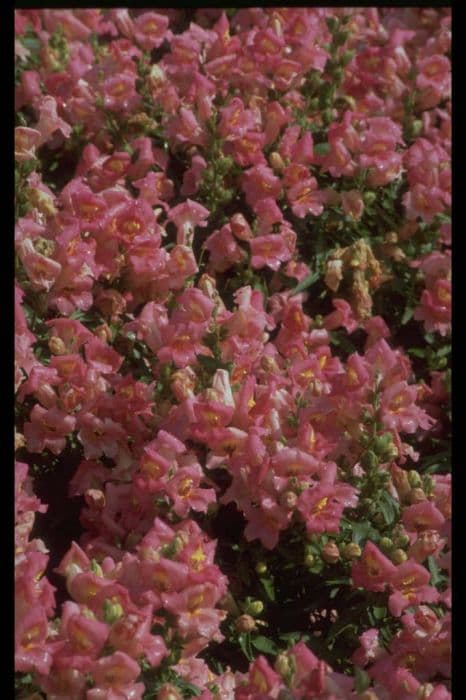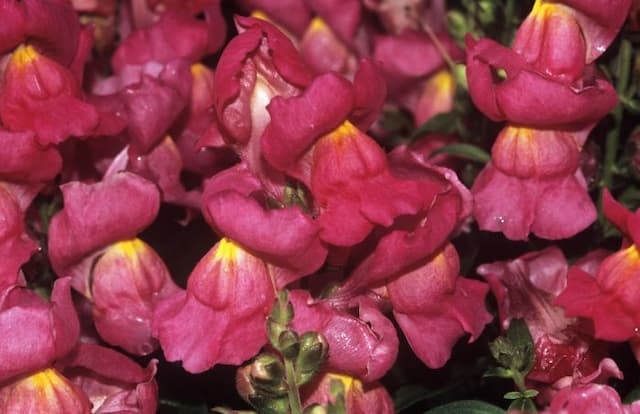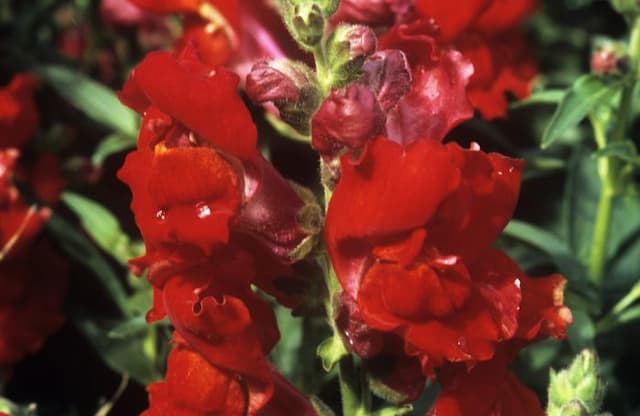Penstemon 'Delfts Blue Riding Hood' Penstemon 'Delfts Blue Riding Hood' (PBR) (Riding Hood Series)

ABOUT
'Delfts Blue Riding Hood' has blue to indigo flowers. It's a compact, well-branched cultivar reaching about 60cm in height
About this plant
 Names
NamesFamily
Plantaginaceae
Synonyms
Beardtongue, Delfts Blue Beardtongue
Common names
Penstemon 'Delfts Blue Riding Hood'
 Characteristics
CharacteristicsLife cycle
Perennials
Foliage type
Deciduous
Color of leaves
Green
Flower color
Blue
Height
1-2 feet (30-60 cm)
Spread
1-2 feet (30-60 cm)
Plant type
Herb
Hardiness zones
4-9
Native area
North America
Benefits
 General Benefits
General Benefits- Attracts Pollinators: This plant attracts bees, butterflies, and other beneficial insects to the garden, helping to pollinate other plants.
- Aesthetic Appeal: With its striking 'Delfts Blue' flowers and tidy foliage, it adds visual interest and beauty to any landscape.
- Drought Tolerance: Once established, it has good drought tolerance, making it suitable for xeriscaping or water-efficient gardening.
- Low Maintenance: Requiring minimal care beyond the occasional pruning and deadheading, it's a great choice for both novice and expert gardeners.
- Cold Hardy: It can withstand cold temperatures, suitable for growing in a variety of climates.
- Long Blooming: Provides a long season of color in the garden with its lengthy blooming period.
- Deer Resistance: Typically resistant to deer, which can help to reduce damage to the garden caused by wildlife.
 Medical Properties
Medical PropertiesThis plant is not used for medical purposes.
 Air-purifying Qualities
Air-purifying QualitiesThis plant is not specifically known for air purifying qualities.
 Other Uses
Other Uses- Penstemon can be used in pressed flower art due to their colorful and structured flowers which retain good color and shape when dried and pressed.
- The flowers of Penstemon can be employed in educational settings for plant biology studies, especially involving pollination and plant reproduction research.
- In photography, the vibrant hues and intricate shapes of Penstemon blossoms make them great subjects for macro and nature photography.
- Penstemon can be used as a natural dye source, providing colorants for fabrics or artisan crafts, though not as commonly known for this purpose.
- For hobbyists who enjoy model landscaping such as in model railroading, Penstemon flowers can be scaled down and used to create realistic miniature landscapes.
- Promoting biodiversity, Penstemon flowers are planted to attract and support native bees, butterflies, and hummingbirds in conservation gardens or wildlife corridors.
- Penstemon cuttings can be used in floral arrangements, bringing unique textures and a wide range of colors to mixed bouquets or standalone displays.
- In sensory gardens, Penstemon plants with their noticeable flowers and foliage can be used to provide an aesthetic and tactile experience for visitors.
- When planted in mass, Penstemon can function as a soil erosion control measure on slopes or banks with their root systems helping to stabilize the ground.
- Penstemon’s vibrant flowers are used in garden design for color theming, as they provide an excellent range of blues and purples for cool-toned garden palettes.
Interesting Facts
 Feng Shui
Feng ShuiThe Penstemon is not used in Feng Shui practice.
 Zodiac Sign Compitability
Zodiac Sign CompitabilityThe Penstemon is not used in astrology practice.
 Plant Symbolism
Plant Symbolism- Resilience: Penstemons, also known as beardtongues, often symbolize resilience as they thrive in harsh environments and have the ability to bounce back from challenging conditions.
- Eloquence: The common name "beardtongue" can be associated with fluent or persuasive speaking, suggesting that the plant embodies eloquence and clear communication.
- Long-lasting love: Penstemons have a long blooming season which can represent enduring affection in the language of flowers.
- Diversity: With numerous species and varieties, Penstemons can symbolize diversity and variety, reflecting an appreciation for multiple perspectives and uniqueness.
 Water
WaterBeardtongue requires regular watering to maintain evenly moist soil, especially during its blooming period and the first growing season to establish a deep, extensive root system. Water thoroughly but infrequently, about once a week, providing about one inch of water each time which equates to about 0.623 gallons per square yard. During hot, dry spells, increase the frequency to twice a week but always check the soil moisture level first to prevent overwatering. During winter, reduce watering as the plant requires less moisture due to dormancy. Always water the plant at the base to avoid wetting the foliage, which can lead to fungal diseases.
 Light
LightBeardtongue thrives best in full sun conditions, where it can receive at least six to eight hours of direct sunlight daily. A spot that provides morning sun with some afternoon shade is ideal, especially in regions with very hot summers. Avoid deep shade as this can lead to leggy growth and reduced flowering. The plant's vibrant blooms and healthy growth are maximized in an area with ample sunlight.
 Temperature
TemperatureBeardtongue is hardy and can withstand a range of temperatures, but it prefers a range of 60 to 75 degrees Fahrenheit for optimal growth. Although it can survive temperatures as low as 20 degrees Fahrenheit, it’s best to protect it from frost. During summer, it can tolerate high temperatures if provided with sufficient water. The ideal temperatures will promote healthy foliage and abundant flowering.
 Pruning
PruningPrune beardtongue to encourage bushier growth, improve air circulation, and promote more blooms. Deadheading spent flowers regularly can help encourage a second flush of blooms. At the end of the blooming season, cut back the entire plant to about one to three inches above the ground. Pruning is best done in late fall or early spring before new growth resumes.
 Cleaning
CleaningAs needed
 Soil
SoilBeardtongue thrives in well-draining soil with a mixture of loam and sand, enriched with organic matter. It prefers a slightly acidic to neutral pH of 6.0 to 7.0.
 Repotting
RepottingBeardtongue does not require frequent repotting; repot only when it outgrows its current container, typically every 2-3 years.
 Humidity & Misting
Humidity & MistingBeardtongue prefers average to low humidity levels; it does not require any special humidity considerations as long as soil moisture is maintained appropriately.
 Suitable locations
Suitable locationsIndoor
Provide full sun, well-draining soil, and regular watering.
Outdoor
Plant in full sun, in well-draining soil, and water regularly.
Hardiness zone
4-9 USDA
 Life cycle
Life cycleThe life cycle of Penstemon 'Delfts Blue Riding Hood', also known as Beardtongue, begins with seed germination, typically in early to mid-spring, where the seeds sprout and establish a small rosette of leaves at the soil surface. As the weather warms, vegetative growth accelerates, and the plant develops a sturdy stem and a fuller foliage structure. By late spring to early summer, it begins to flower, producing tall spikes adorned with bell-shaped blue flowers that are attractive to bees and butterflies. After pollination, usually by these visiting pollinators, the flowers will develop into small seed capsules by late summer or early fall. The seeds can be dispersed by wind or wildlife, perpetuating the cycle. During winter, the plant may die back, especially in colder climates, entering a period of dormancy until the warmth of spring prompts new growth, starting the cycle anew.
 Propogation
PropogationPropogation time
Spring to early summer
The most popular method for propagating Penstemon 'Delft Blue Riding Hood' is by softwood cuttings. Take cuttings in late spring or early summer, when the plant is growing vigorously. Select a healthy stem with new growth, measuring about 3-4 inches (approximately 7.5-10 centimeters) in length, and make a clean cut just below a leaf node using a sharp, sterilized pair of scissors or pruning shears. Remove the lower leaves to expose the nodes and dip the cut end into a rooting hormone to encourage root development. Plant the cutting in a container filled with a well-draining potting mix, ensuring that the exposed nodes are buried. Water the cutting gently and place it in a warm, bright area out of direct sunlight. Keep the soil consistently moist but not waterlogged, and within a few weeks, the cutting should begin to grow roots, at which point it can eventually be transplanted outdoors.









